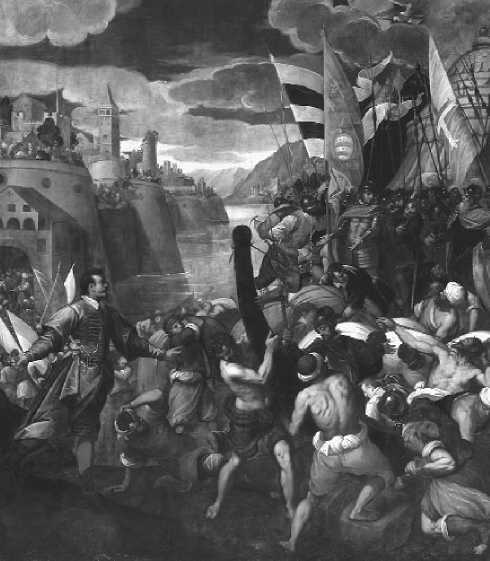A major Venetian naval crusade that succeeded in crippling the Fatimid navy in 1123 and capturing the city of Tyre (mod. Sour, Lebanon) in Palestine in 1124.
After the disastrous defeat of the Franks of Outremer at the battle known as the Ager Sanguinis (the Field of Blood) in 1119, King Baldwin II of Jerusalem sent an urgent appeal for assistance to Pope Calixtus II and Doge Domenico Michiel of Venice. A group of papal ambassadors took a letter from the pope to the Venetians, asking them to have mercy on the Christians of the East by coming quickly to their aid. Having called an assembly of all citizens at San Marco, Michiel gave a stirring speech in support of the crusade. The response was tremendous: with shouts of assent, the doge himself took the cross, followed by his people. All Venetians engaged in overseas commerce were ordered to return to Venice in preparation for the crusade.
After assembling or building a fleet of approximately 120 major vessels, the Venetian crusaders, numbering some 15,000, departed from the Venetian lagoon in August 1122.

Doge Domenico Michiel orders that the ships’ sails and rudders be brought ashore to assure the Franks that the Venetians will not leave the Holy Land without conquering Tyre (1123), by Antonio Vassilacchi Aliense (1556-1629). (Cameraphoto/Art Resource)
They wintered on Corfu (mod. Kerkira, Greece), where they besieged the Byzantine stronghold in retaliation for Emperor John II Komnenos’s refusal to honor Venetian commercial privileges. Early in spring 1123, the Venetians learned of Baldwin II’s capture by the Turks, abandoned the siege, and sailed immediately for Outremer. At Cyprus, they heard that a powerful Egyptian fleet was threatening Jaffa (mod. Tel Aviv-Yafo, Israel), and Michiel ordered his ships to intercept it. Off the coast near Ascalon (mod. Tel Ashqelon, Israel), Michiel cleverly hid his war galleys behind the large transport vessels, deceiving the Fatimids into believing that the Venetian fleet was an unarmed pilgrimage convoy. When the Egyptian vessels approached, they were surrounded and captured or destroyed. It was a tremendous victory, effectively handing control of the sea to the Christians.
The Venetians proceeded to Acre (mod. ‘Akko, Israel), where they agreed to help the Franks capture the important coastal city of Tyre. An agreement was drawn up (the Pactum Warmundi) that promised the Venetians one-third of Tyre, a quarter in every city in the kingdom, and various privileges in return for their assistance. The siege was predominantly a Venetian enterprise, since they far outnumbered their Frankish allies. After failing to breach the sea walls, the Venetians beached their vessels and continued the siege by land. Tyre finally surrendered in early summer 1124. On their journey home the Venetians again harassed Byzantine territories in an unsuccessful attempt to compel the emperor to honor their privileges. They returned to Venice and a hero’s welcome in summer 1125.
-Thomas F. Madden
Bibliography
Queller, Donald E., and Irene B. Katele, “Venice and the Conquest of the Latin Kingdom of Jerusalem,” Studi Veneziani, n. s., 12 (1986), 15-43.
Riley-Smith, Jonathan, “The Venetian Crusade of 1122-1124,” in I Comuni italiani nel regno crociato di Gerusalemme, ed. Gabriella Airaldi and Benjamin Z. Kedar (Genova: Universita di Genova, 1986), pp. 337-350.




 World History
World History









